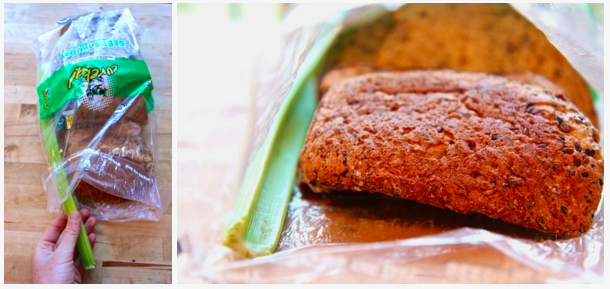Can you cut 1 Tonne of carbon pollution out of your life?
Take the challengeMy partner is French, so it's pretty rare for bread to go uneaten in our household. But on the rare occasion that it gets hard and stale before we get the chance to eat it there's a few tricks I have up my sleeve to give it a new life.
Keeping bread fresh is a losing battle, from the moment it is done baking it begins to lose it's moisture through a process called starch retrogradation. In the original baking process, the starch began to gelatinise above 60C and absorb moisture. Once absorbed, the starches swell and create the spongy fresh solid texture we associate with bread. As the starches recrystallise over time they loose the moisture that was once locked in the baking process. By simply reheating your bread your starches will re-gelatinise and reinstall the soft texture we have come to associate with "fresh"
The Microwave Method
This method is by far the fastest way to soften your stale bread and has the longest lasting results.
Steps:
Moisten a section of tea-towel long enough to completely cover your loaf of bread (or the portion that you intend to eat). Do so by soaking your towel in cold water, and then squeeze out as much of the water as you can.
Wrap your portion of bread in your damp tea-towel snuggly.
Place your covered loaf or slice into your microwave.
Microwave for 10 seconds.
Remove your bread from the microwave.
Remove it's tea-towel covering.
Serve!
The Oven Method
The oven method takes longer to soften the bread than the microwave method but works just as well.
Steps:
Preheat your oven to 150C (300F).
Tear off a piece of aluminum foil large enough to cover and wrap your bread loaf/slice in.
Wrap your bread in the aluminum taking care to make sure it is completely covered.
Place your foil covered bread into your warm oven for 5-20 minutes. If you are just heating a slice or small roll, you'll want to warm it for less time (closer to 5 minutes) than if you are warming and remoistening a larger or thicker loaf of bread (closer to 20 minutes).
Remove your bread from the oven and allow it to cool within the foil. You'll want to let your bread remoisten inside the foil so that as it cools it doesn't release it's remaining moisture as steam.
Serve and eat as soon as it's cool enough to touch.
If your bread is really dry, I occasionally dab a couple drops of water along the length of the bread loaf with my fingers. This will help to reincorporate moisture into your loaf beyond just reheating and softening. If you decide to add water, make sure that you don't over saturate your bread loaf otherwise you'll end up with mushy bread. Start small, you can always add more.
The Celery Method
The celery method is preferential for remoistening bags of sliced bread; however, it takes a little bit of foresight since you'll be letting it reabsorb moisture overnight.
Steps:
Slide a celery stalk inside your bread loaf bag.
Seal or close off your bag.
Place your bread bag with celery stalk back into the fridge and let it sit for several hours. I have had the best results when it sits overnight in the fridge.
Remove your celery stalk from the bag. It should be fairly dry and tough by this point having lost most of it's moisture the bread.

There is the possibility that your bread has dried out beyond reasonable or easy remoistening. If this is the case, try reusing your bread in other ways: make bread crumbs, make croutons, thicken a soup, or feed the birds!
This post was adapted from an Instructable originally posted by Kellymarie
Try this next: DIY your own laundry detergent
Read this next: How to Live Your Life Free of Large Supermarket Chains

